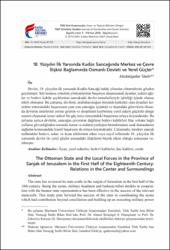| dc.contributor.author | Steih, Abdalqader | |
| dc.date.accessioned | 2016-12-29T10:58:45Z | |
| dc.date.available | 2016-12-29T10:58:45Z | |
| dc.date.issued | 2016 | |
| dc.identifier.citation | STEIH, Abdalqader. "18. Yüzyılın İlk Yarısında Kudüs Sancağında Merkez ve Çevre İlişkisi Bağlamında Osmanlı Devleti ve Yerel Güçler." FSM İlmî Araştırmalar İnsan ve Toplum Bilimleri Dergisi, 8 (2016): 241-257. | en_US |
| dc.identifier.uri | https://hdl.handle.net/11352/2434 | |
| dc.description.abstract | Devlet, 18. yüzyılın ilk yarısında Kudüs Sancağı’ndaki yönetim yöntemlerini gözden
geçirmiştir. Söz konusu yönetim yöntemlerinin başarıya ulaşmasında âyanlar, askeri ağalar
ve bedevi kabile şeyhlerinin sancaktaki devlet temsilcileriyle işbirliği içinde olması
etkili olmuştur. Bu çalışma, devletin, arabuluculuğun ötesinde katkıları olan âyanları koordine
etmesindeki başarısının yanı sıra sancağın içindeki ve dışındaki görevlerin ifasında
devletin emirlerini yerine getiren ve disiplinini kaybetmiş yerel askeri güçlerle denge
unsuru oluşturan icracı askeri bir güç tesis etmesindeki başarısını ortaya koymaktadır. Bu
çalışma ayrıca devletin, sancağın çevresine dağılmış bedevi kabileleri Hac yoluna bağlı
yolların güvenliğinden sorumlu tutma ve onların yerleşim birimlerinden uzak durmalarını
sağlama konusundaki kısmî başarısını da ortaya koymaktadır. Çalışmada, modern sancak
tarihindeki bedevi, asker ve âyan ailelerinin etkin veya zayıf rollerinde 18. yüzyılın ilk
yarısında devlet ile yerel güçler arasındaki ilişkilerin büyük etkisi olduğu sonucuna varılmıştır. | en_US |
| dc.description.abstract | The state has reviewed its state crafts in the sanjak of Jerusalem in the first half of the
18th century. Being the ayans, military headmen and bedouin tribal sheikhs in cooperation
with the banner state representative has been effective in the success of the relevant
statecrafts. This study puts forward the success of the state in coordinating the ayans
which had contribution beyond conciliation and building up an executing military power that equipoise undisciplined local military forces who fulfill the orders of the state during
the performance of duties within and outside the banner. Moreover this study sets forth
the partial success of the state in providing the Bedouin tribes scattered around the banner
in holding them responsible for the safety of the linking roads of the pilgrimage route
and ensuring them to stay away from residential areas. It has been concluded from the
study that there is a big impact of the relationship between the state and local powers in
the active or weak roles of the bedouin, military and ayans’ families in the modern banner
history in the first half of the 18th century. | en_US |
| dc.language.iso | tur | en_US |
| dc.publisher | FSM Vakıf Üniversitesi | en_US |
| dc.rights | info:eu-repo/semantics/openAccess | en_US |
| dc.subject | Âyan | en_US |
| dc.subject | Yerel askerler | en_US |
| dc.subject | Bedevî kabileler | en_US |
| dc.subject | Hac kafilesi | en_US |
| dc.subject | Cerde | en_US |
| dc.subject | Ayans | en_US |
| dc.subject | Local military | en_US |
| dc.subject | Bedouin tribes | en_US |
| dc.subject | Hajj convoy | en_US |
| dc.title | 18. Yüzyılın İlk Yarısında Kudüs Sancağında Merkez ve Çevre İlişkisi Bağlamında Osmanlı Devleti ve Yerel Güçler | en_US |
| dc.title.alternative | The Ottoman State and the Local Forces in the Province of Sanjak of Jerusalem in the First Half of the Eighteenth Century: Relations in the Center and Surroundings | en_US |
| dc.type | article | en_US |
| dc.contributor.department | Marmara Üniversitesi, Türkiyat Araştırmaları Enstitüsü, Türk Tarihi Ana Bilim Dalı, Yeniçağ Tarihi Bilim Dalı | en_US |
| dc.relation.publicationcategory | Makale - Ulusal - Editör Denetimli Dergi | en_US |



















